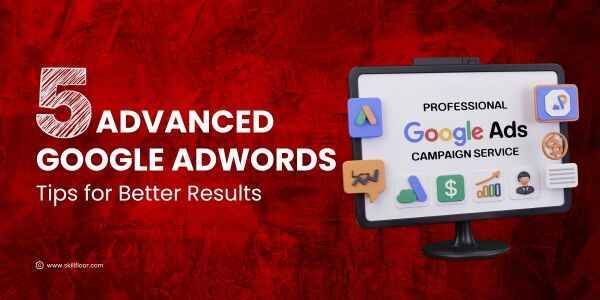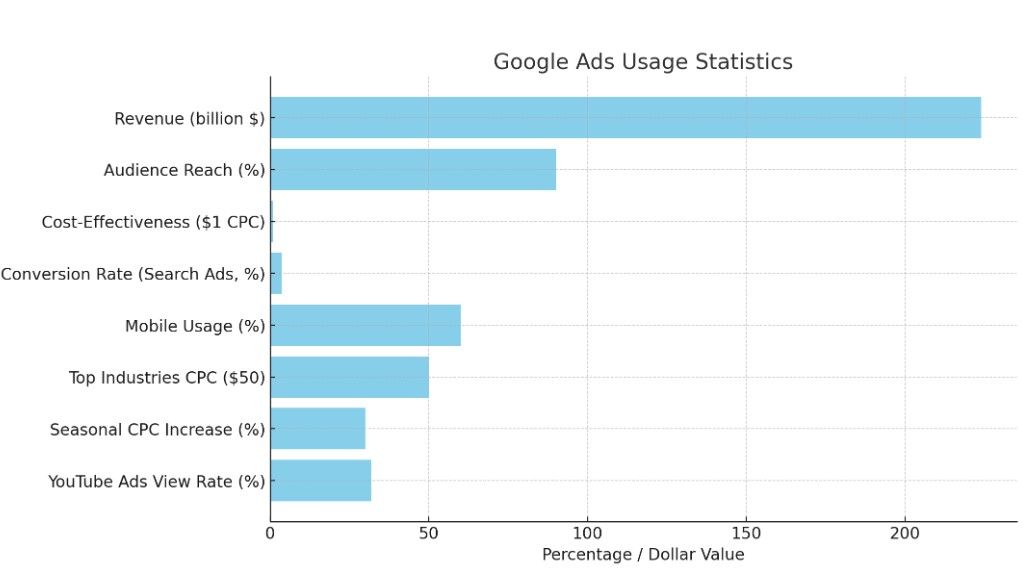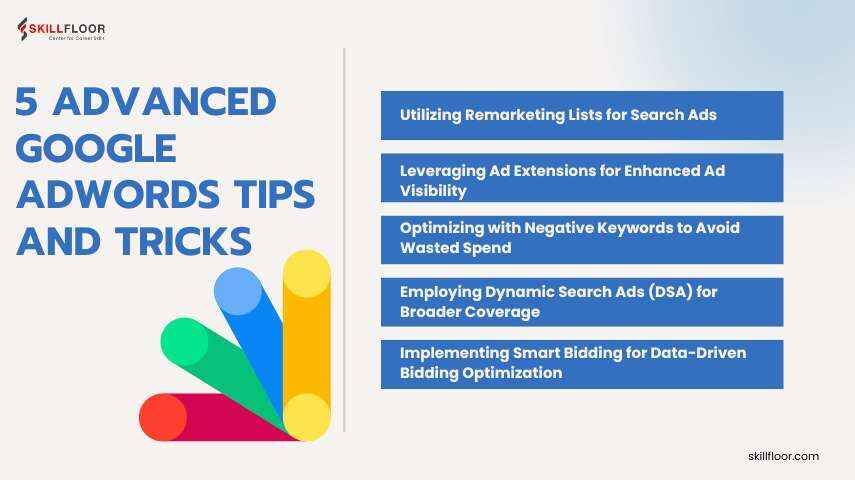5 advanced Google AdWords tips and tricks
Boost your Google AdWords performance with 5 advanced tips including RLSA, Ad Extensions, Smart Bidding, and more. Improve conversions and ROI today!

It has been an exciting journey learning about the world of digital marketing! Having worked in this field for a few years, I have seen successful campaigns and ones requiring additional tweaking. Keywords, bidding, and targeting were among the fundamentals I learned in my first digital marketing course, but nothing prepared me for the depth of understanding you receive from really diving into Google AdWords. It may be exciting but sometimes unpredictable, much like a rollercoaster, as anyone who has worked with it knows!
I eventually started experimenting with AdWords' hidden features and functions, moving beyond the basics. I've learned through trial and error what exactly makes a campaign successful, from strategically depending on data to strategically increasing bids at the ideal moment. Just by adjusting your bid strategies or testing with in-market categories, you may potentially double your conversion rate.
Let's go through the 5 advanced Google AdWords strategies that have regularly raised the standard of my ads from average to outstanding. These insights go beyond the basics and offer strategies that can help you advance your efforts. Let's use Google AdWords to its best potential, one clever technique at a time!
What is Google AdWords?
Businesses can advertise on YouTube, Google's search results, and other partner websites with Google AdWords, currently known as Google Ads. Advertisers who utilize a pay-per-click (PPC) model place bids on particular keywords, allowing their adverts to show up when users look up related words.
For example, a company that sells eco-friendly cleaning supplies may place bids on keywords like "natural cleaning products" or "eco-friendly cleaners." The advertisement may show up when a user searches for these terms, encouraging them to click and possibly convert. By enabling strategic targeting, Google AdWords helps companies of all sizes reach clients according to intent, demography, and other factors.
The Significance of Google AdWords in Digital Marketing
Google visibility is essential in the tough world of digital marketing. AdWords ensures that a brand's message reaches customers at the exact time that they are searching for goods or services, due to the billions of searches it receives every day. Companies may get visibility right away using AdWords, so they don't have to rely just on organic search rankings.
For example, setting a targeted ad budget focused on high-intent keywords, can help a small business compete with big names in the industry. Thus, Google AdWords creates an even playing field, giving companies a means to improve lead generation, increase brand awareness, and swiftly establish traction.
Core Benefits of Using Google AdWords
-
Immediate Traffic: Unlike SEO, which can take time to develop, Google AdWords provides quick results with advertising that shows up practically quickly.
-
Budget Control: Google AdWords gives businesses the ability to set daily spending caps, modify their expenditures, and prevent overspending.
-
Accurate Targeting: Google AdWords makes it simple to connect with particular audience segments by offering choices to target consumers based on their location, device, and time.
-
Extensive Analytics: Businesses may improve their advertising strategy by utilizing the platform's strong metrics and reporting capabilities.
-
Increased Brand Visibility: Just showing up on the first page of Google results raises brand awareness even if visitors choose not to click on an advertisement.
Setting Up for Success: Google AdWords Best Practices
It's important to establish a strong foundation by following these best practices before advancing into more complex strategies:
-
Thorough Keyword Research: Use tools such as Google Keyword Planner or SEMrush to find high-intent keywords, paying particular attention to terms that are pertinent to your offering.
-
Relevance in Ad Copy: Your advertisements should be valuable and directly relate to the keywords, addressing the interest or pain point of the user.
-
Clear Landing Page Experience: Make sure the landing page delivers on the promise of the advertisement by having an intuitive layout and a clear call to action.
-
A/B Testing for Continuous Improvement: To determine the most effective combination, test multiple variations of ad headlines, descriptions, and calls to action on a regular basis.
Usage of Google Ads on Various Platforms
The effectiveness, reach, and influence on businesses of Google AdWords (now known as Google Ads) can be seen in several statistics. The following statistics analysis focuses on significant elements of Google Ads usage:
-
Revenue: Generates over $224 billion annually, holding 29% of the global digital ad market.
-
Audience Reach: Reaches 90% of global internet users; Google sees 8.5 billion searches daily.
-
Cost-Effectiveness: Average CPC is $1–$2 (search) and $0.58 (display). Advertisers gain $2 in revenue per $1 spent.
-
Conversion Rates: Averages 3.75% for search ads, with higher rates for certain industries.
-
Mobile Usage: Accounts for 60% of ad clicks, but desktop still yields higher conversion rates.
-
Top Industries: Retail, travel, finance, and healthcare lead in spending; finance CPC can exceed $50.
-
Ad Formats: Search ads (46% of revenue), display (16%), and YouTube video ads (31.9% view rate) perform well.
-
Seasonality: Ad costs can rise 25-30% during holidays, especially in e-commerce and retail.
-
YouTube Ads: View rates average 31.9%.
Google Ads remains essential for high ROI, especially during peak shopping seasons.

5 Advanced Google AdWords Tips and Tricks
After going over the basics, let's explore five advanced Google AdWords strategies to improve campaigns and increase the return on your investment.

1. Utilizing Remarketing Lists for Search Ads (RLSA) for Strategic Re-engagement
One of Google AdWords' most effective features is Remarketing Lists for Search Ads (RLSA), which lets you connect with people who have already been to your website while they are still searching. RLSA raises the likelihood that potential buyers who are already familiar with your brand will convert by re-engaging them with targeted adverts.
How to Use RLSA Effectively:
-
Audience Segmentation: Segment your audience according to particular behaviors, including viewing product pages, leaving carts, or spending time on a particular page. For example, a specific advertisement showcasing a particular product may be displayed to people who have viewed it but have not made a purchase.
-
Bidding Adjustments: Since returning visitors are more likely to convert than first-time visitors, up your bid for them.
-
Customized Ads: Create ad copy, especially for remarketing audiences with customized ads. For example, people who looked at a product but didn't buy it a discount code, to encourage them to come back and finish the transaction.
2. Leveraging Ad Extensions for Enhanced Ad Visibility
Ad extensions are extra bits of information that you may add to your advertisements to encourage visitors to click. They increase ads' contact and individuality, which frequently results in greater click-through rates (CTR). Sitelinks, callouts, structured snippets, and location extensions are examples of common types.
Ad Extension Types and Their Uses:
-
Sitelink Extensions: Let people get straight to the sites they're interested in by including links to other sections of your website, such as product pages or exclusive deals.
-
Callout Extensions: These short expressions draw attention to services like "Free Shipping" or "24/7 Support." Make use of them to stand out from the competition and draw in users.
-
Structured Snippets: Give visitors a brief overview of your product by highlighting particular features, such as "Popular Features" or "Available Colors."
-
Location Extensions: Ideal for companies with physical locations, these extensions provide a map, driving directions, and phone numbers in addition to information about where users can find you.
Your ad's relevancy and quality score can be greatly raised by using ad extensions, which will ultimately result in better ad placement and cheaper costs per click.
3. Optimizing with Negative Keywords to Avoid Wasted Spend
Because they keep your ads from showing for irrelevant searches, negative keywords are essential for improving targeting. You can make sure your ad budget is going to users who are more likely to convert by using negative keywords.
How Negative Keyword Optimization Works:
-
Identify Negative Keywords: To find irrelevant keywords that are causing your ads to appear, periodically review the AdWords search terms report. For instance, you might want to use negative keywords like "cheap" or "free" if you're promoting high-end handbags.
-
Organize and segment: To ensure relevancy, group negative keywords into categories that do not overlap with your major keyword groups.
-
Use Broad Negative Keywords Sparingly: Broad negative keywords may decrease visibility even as they block more searches. Review the effects of broad negatives regularly to avoid targeting that is too restrictive.
You may boost ROI, reduce unnecessary clicks, and lessen overall expenses by using negative keywords effectively.

4. Employing Dynamic Search Ads (DSA) for Broader Coverage
For companies with sizable websites or substantial stock, Dynamic Search Ads (DSA) is an excellent tool. DSA, in contrast to traditional advertisements, creates adverts automatically based on the content of your website, increasing your reach by focusing on more relevant queries.
Strategies for Effective DSA Campaigns:
-
Use Negative Keywords: Use negative keywords that might draw non-converting users to avoid irrelevant traffic. For example, if you are not aiming for research-based searches, do not include "review."
-
Use for Category Pages: Configure DSAs to target category pages, such as "summer shoes" or "outdoor furniture," rather than individual products. This can keep the advertisements relevant while drawing in users who are generally interested.
-
Closely Monitor Performance: DSA campaigns have the potential to generate a lot of traffic. Examine performance on a regular basis to find any low-quality or irrelevant clicks that could waste your money.
You may acquire new clients without doing a lot of keyword research because of Dynamic Search Ads, which streamline campaign management. To preserve cost-effectiveness, however, careful observation is essential.
5. Implementing Smart Bidding for Data-Driven Bidding Optimization
A collection of automated bidding techniques called "Smart Bidding" uses machine learning to modify bids in real-time, improving conversion rates. Google AdWords allows for a more data-driven strategy by considering a variety of criteria, including device, location, and user activity.
Smart Bidding Strategy Types:
-
Target CPA (Cost Per Acquisition): This strategy automatically modifies bids to help you reach your goal CPA, making it perfect for companies that are committed to maintaining a particular cost per conversion.
-
Target ROAS (Return on Ad Spend): A defined return on ad expenditure is the goal of the target ROAS (Return on Ad expenditure) strategy, which focuses on optimizing profitability. Businesses with different product values or higher-value conversions can benefit from it.
-
Maximize Conversions: This strategy is useful if you want to increase the number of conversions while staying within your budget, particularly if lead creation is your main objective.
-
Maximize Clicks: This strategy is perfect for raising website traffic and works well for awareness campaigns when traffic volume is more important than conversions right away.
Businesses that use Smart Bidding can make use of advanced machine learning algorithms that continuously adjust bids based on real-time insights, improving outcomes without requiring a lot of manual labor.
Additional Tips for Advanced AdWords Management
Here are some extra methods to improve your Google AdWords campaigns in addition to the primary ones:
Regularly Performing A/B Testing to Promote Continuous Improvement: You may learn more about what appeals to your audience by testing different aspects of your landing pages, CTAs, and ad language. To continuously improve your messaging, test different headlines, descriptions, and calls to action.
Tracking the Quality Score to Boost Ad Performance: The Google AdWords Quality Score affects both your cost-per-click and ad rank. Better placement at a lesser cost is frequently the result of higher quality scores. This score is influenced by elements such as click-through rate, landing page quality, and ad relevancy. To increase your ad efficiency and Quality Score, concentrate on making these improvements.
Evaluating Trend-Based and Seasonal Keywords: Keep abreast of seasonal events or trends, such as holidays, sales events, or changes in the industry, that may affect the interests of your audience. Make sure your advertisements stay relevant by modifying your keywords and ad wording to correspond with these trends.
Using Google Analytics for Enhanced AdWords Insights
You can gain a more thorough understanding of user activity after they click on your advertising by connecting Google Analytics to your AdWords account. Analytics allows you to analyze custom conversions, determine which ads generate excellent traffic, and learn about the demographics of your audience. Additionally, it provides attribution data, engagement analytics, and bounce rate, helping in campaign optimization and ad performance enhancement. To integrate, connect your Analytics account under "Linked Accounts" in the AdWords settings. This simple link enables more informed changes that can improve your AdWords performance.
It takes a balance of smart targeting, continuous analysis, and optimization to get the most out of Google AdWords. By using these advanced strategies, such as remarketing, DSAs, and Smart Bidding, you can boost conversions, generate more relevant traffic, and get better returns on your advertising investment. To maintain your company at the forefront of digital marketing, keep up with new AdWords features and continually improve your campaigns because the digital world is always changing.




























































